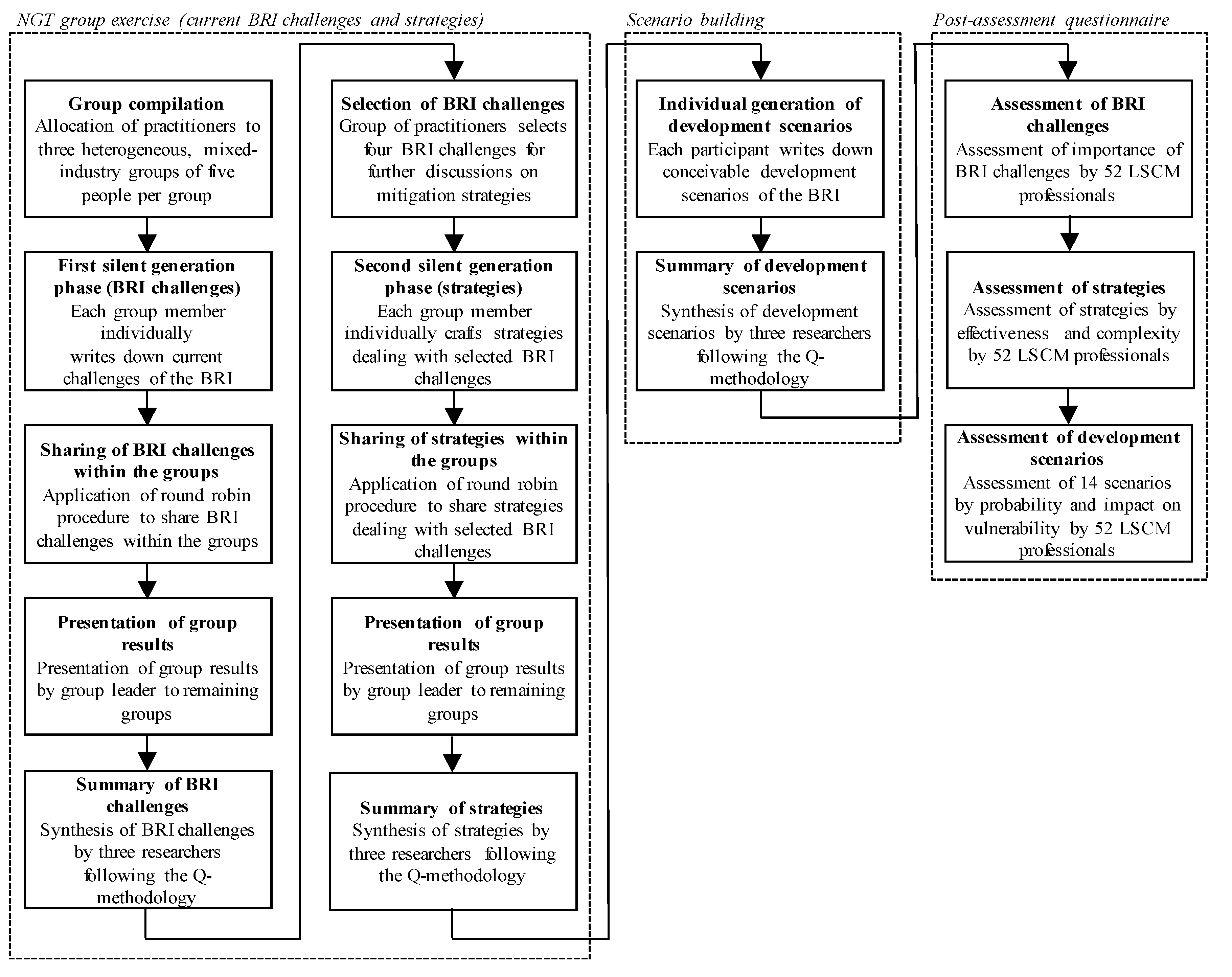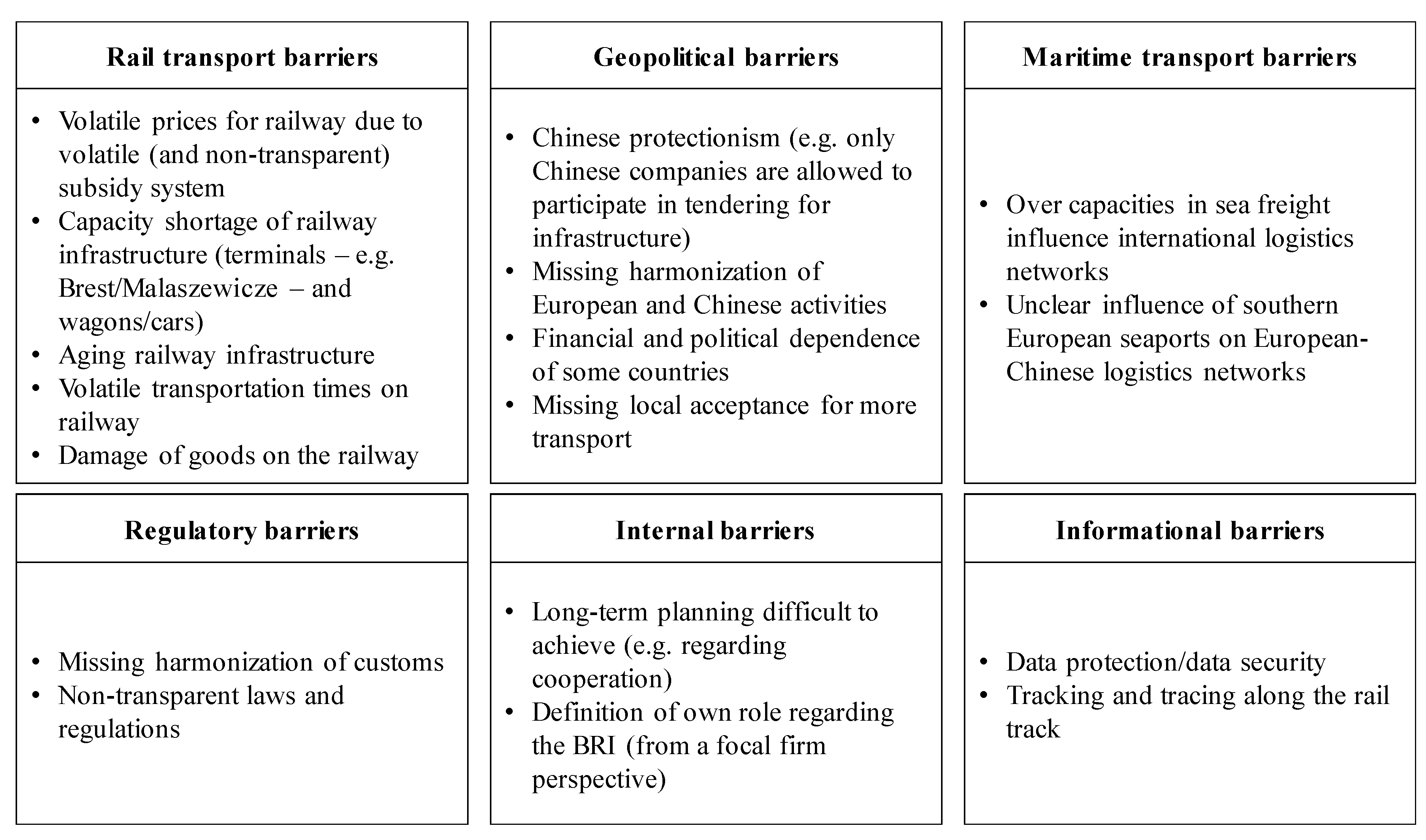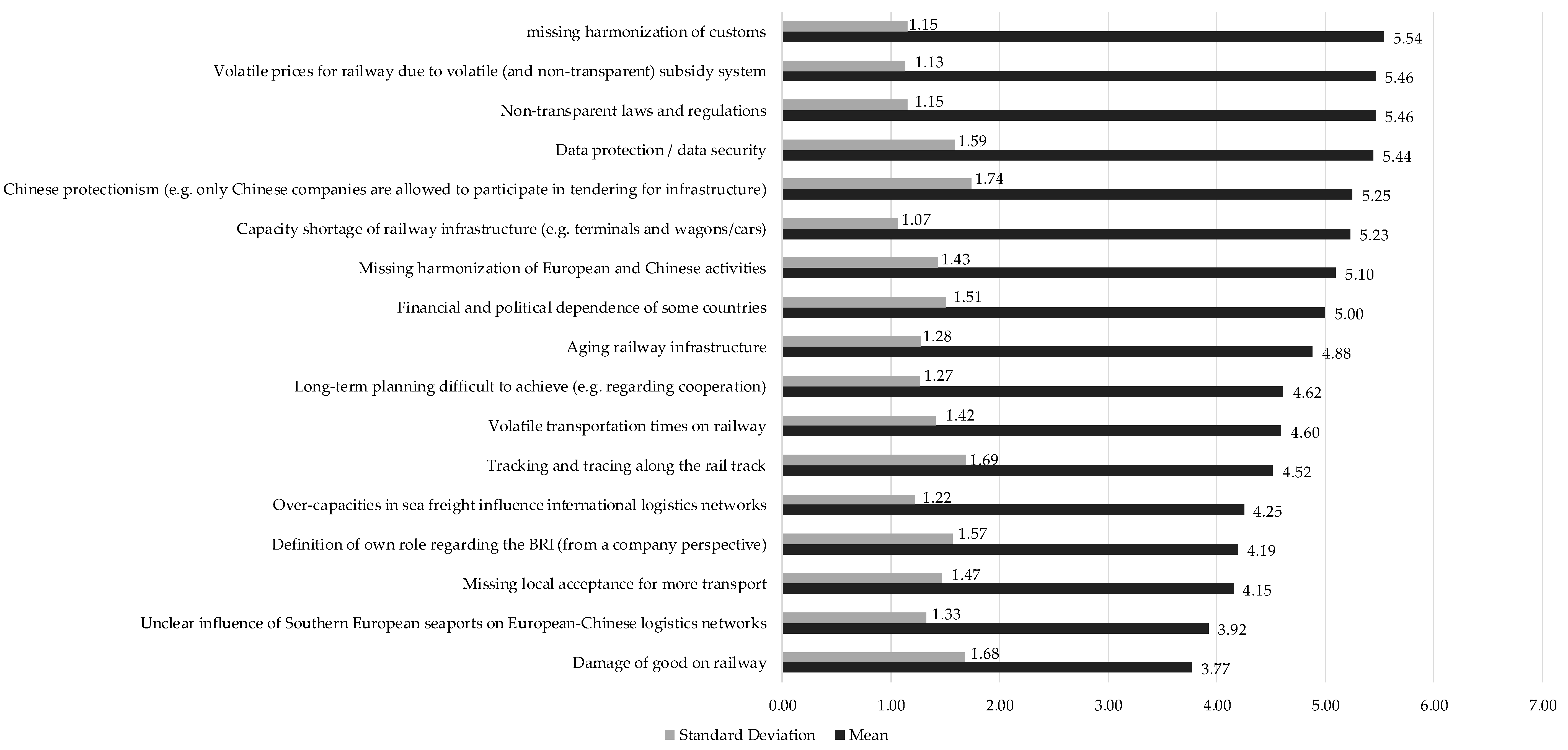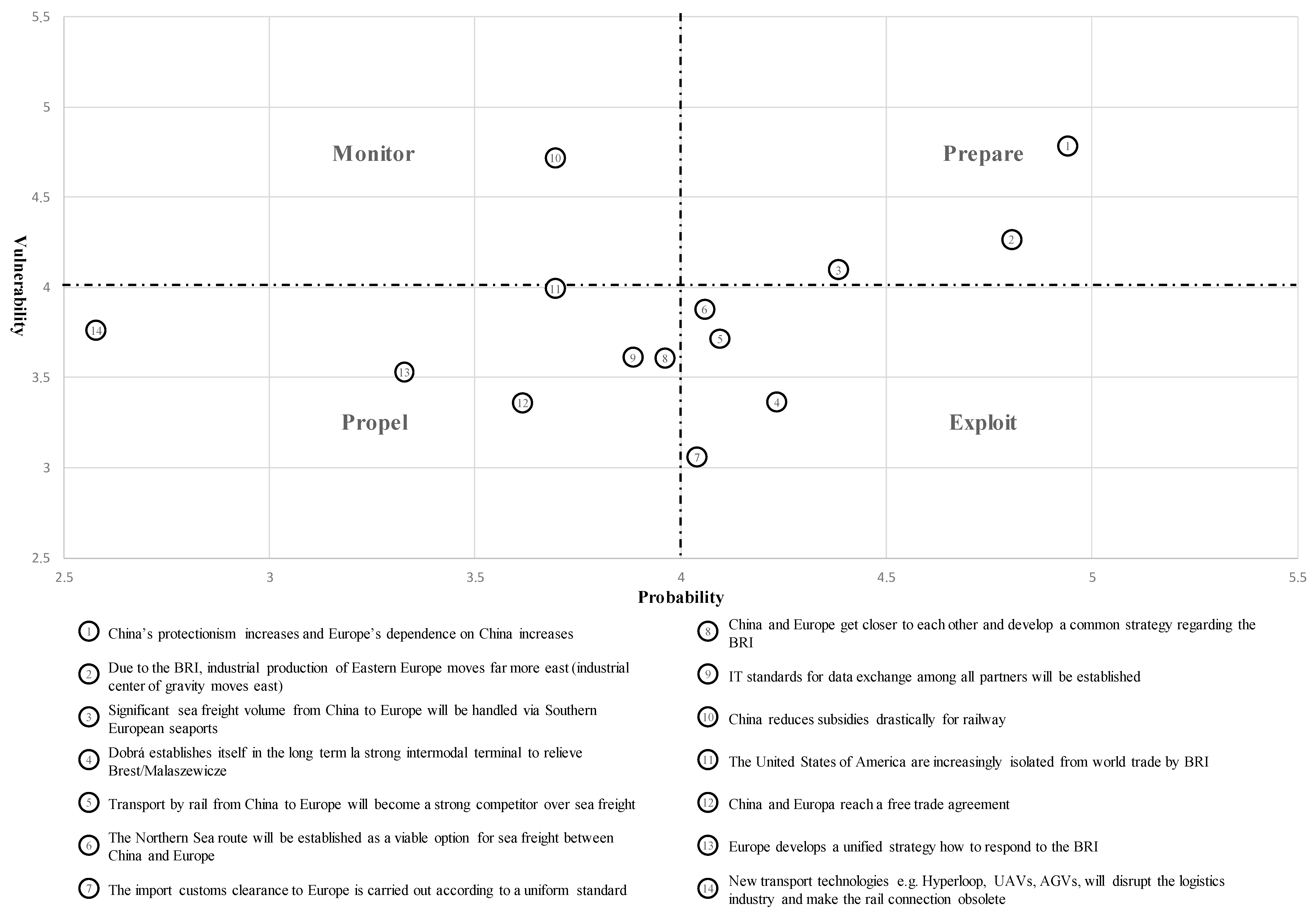Decrypting the Belt and Road Initiative: Barriers and Development Paths for Global Logistics Networks
Abstract
1. Introduction
- RO1: Outline and assess the current barriers that the BRI presents, from an LSCM perspective, that inhibit efficient operations along BRI paths.
- RO2: Provide indications of strategies for dealing with current BRI barriers.
- RO3: Propose and assess future development scenarios for the BRI.
2. Background of the Belt and Road Initiative
3. Research Design
3.1. First Stage: Group Exercise to Derive BRI Barriers, Strategies, and Development Scenarios
3.2. Second Stage: Assessment of BRI Barriers, Strategies, and Development Scenarios
4. Results
4.1. Current BRI Barriers
Our clients are used to having fixed prices for certain transport routes and volumes. In the case of rail transportation between China and Germany we are struggling to provide fixed prices since the subsidies for Chinese rail terminals are changing constantly. Once we establish a profitable and stable connection we have to change the domestic terminal to remain profitable, which leads to problems for our logistics planning on a regular basis. However, without the Chinese subsidies, the demand for rail transportation would be much lower than it is today.
A few years ago, a train between Xi’an and Duisburg took around twelve days on average. Today, in 2019, this connection takes around 16 days, sometimes even more, which is mainly caused by the infrastructure bottleneck that we face at the Malaszewicze/Brest terminal.
Europe and China are the most important trade partners regarding the Belt and Road Initiative but are not working together as closely as necessary. If everything is done correctly, the initiative can be a win-win situation for all countries and stakeholders involved since it facilitates trade and consequently economic development. But currently, it seems to me that Europe does not have a unified voice to talk to China and to set up joint actions.
4.2. Strategies to Leverage the Potentials of the BRI
4.3. Future Development Paths of the BRI
5. Implications
6. Final Remarks
Funding
Acknowledgments
Conflicts of Interest
References
- Liu, X. The Silk Road in World History; New Oxford World History; Oxford University Press: New York, NY, USA, 2010; ISBN 978-0-19-516174-8. [Google Scholar]
- Ferdinand, P. Westward ho-the China dream and ‘one belt, one road’: Chinese foreign policy under Xi Jinping. Int. Aff. 2016, 92, 941–957. [Google Scholar] [CrossRef]
- Cai, P. Understanding China’s Belt and Road Initiative; Lowy Institute for International Policy: Sydney, Australia, 2017. [Google Scholar]
- Huang, Y. Understanding China’s Belt & Road Initiative: Motivation, framework and assessment. China Econ. Rev. 2016, 40, 314–321. [Google Scholar] [CrossRef]
- Flint, C.; Zhu, C. The geopolitics of connectivity, cooperation, and hegemonic competition: The Belt and Road Initiative. Geoforum 2019, 99, 95–101. [Google Scholar] [CrossRef]
- Yu, H. Motivation behind China’s ‘One Belt, One Road’ Initiatives and Establishment of the Asian Infrastructure Investment Bank. J. Contemp. China 2016, 26, 353–368. [Google Scholar] [CrossRef]
- ZiroMwatela, R.; Changfeng, Z. Africa in China’s ‘One Belt, One Road’ Initiative: A Critical Analysis. IOSR J. Humanit. Soc. Sci. 2016, 21, 10–21. [Google Scholar]
- Ehizuelen, M.M.O. More African countries on the route: The positive and negative impacts of the Belt and Road Initiative. Transnatl. Corp. Rev. 2017, 9, 341–359. [Google Scholar] [CrossRef]
- Shah, A. Building a Sustainable Belt and Road. Horizons 2016, 7, 212–222. [Google Scholar]
- Feng, T.-T.; Kang, Q.; Pan, B.-B.; Yang, Y.-S. Synergies of sustainable development goals between China and countries along the Belt and Road initiative. Curr. Opin. Environ. Sustain. 2019, 39, 167–186. [Google Scholar] [CrossRef]
- Guo, H.; Liu, J.; Qiu, Y.; Menenti, M.; Chen, F.; Uhlir, P.F.; Zhang, L.; Van Genderen, J.; Liang, D.; Natarajan, I.; et al. The Digital Belt and Road program in support of regional sustainability. Int. J. Digit. Earth 2018, 11, 657–669. [Google Scholar] [CrossRef]
- Xiao, H.; Cheng, J.; Wang, X. Does the Belt and Road Initiative Promote Sustainable Development? Evidence from Countries along the Belt and Road. Sustainability 2018, 10, 4370. [Google Scholar] [CrossRef]
- Yu, C.; Zhang, R.; An, L.; Yu, Z. Has China’s Belt and Road Initiative Intensified Bilateral Trade Links between China and the Involved Countries? Sustainability 2020, 12, 6747. [Google Scholar] [CrossRef]
- Gu, J.; Corbett, H.; Leach, M. Introduction: The Belt and Road Initiative and the Sustainable Development Goals: Opportunities and Challenges. IDS Bull. 2019, 50, 50. [Google Scholar] [CrossRef]
- Enderwick, P. The economic growth and development effects of China’s One Belt, One Road Initiative. Strat. Chang. 2018, 27, 447–454. [Google Scholar] [CrossRef]
- Ascensão, F.; Fahrig, L.; Clevenger, A.P.; Corlett, R.T.; Jaeger, J.A.G.; Laurance, W.F.; Pereira, H.M. Environmental challenges for the Belt and Road Initiative. Nat. Sustain. 2018, 1, 206–209. [Google Scholar] [CrossRef]
- Chan, S. The Belt and Road Initiative: Implications for China and East Asian Economies. Cph. J. Asian Stud. 2018, 35, 52–78. [Google Scholar] [CrossRef]
- Du, J.; Zhang, Y. Does One Belt One Road initiative promote Chinese overseas direct investment? China Econ. Rev. 2018, 47, 189–205. [Google Scholar] [CrossRef]
- Herrero, A.G.; Xu, J. China’s Belt and Road Initiative: Can Europe Expect Trade Gains? China World Econ. 2017, 25, 84–99. [Google Scholar] [CrossRef]
- Hurley, J.; Morris, S.; Portelance, G. Examining the debt implications of the Belt and Road Initiative from a policy perspective. J. Infrastruct. Policy Dev. 2019, 3, 139–175. [Google Scholar] [CrossRef]
- Ming Hao, Z. The Belt and Road Initiative and its Implications for China-Europe Relations. Int. Spect. 2016, 51, 109–118. [Google Scholar] [CrossRef]
- Li, K.X.; Jin, M.; Qi, G.; Shi, W.; Ng, A.K.Y. Logistics as a driving force for development under the Belt and Road Initiative—The Chinese model for developing countries. Transp. Rev. 2017, 38, 457–478. [Google Scholar] [CrossRef]
- Lee, P.T.-W.; Hu, Z.-H.; Lee, S.-J.; Choi, K.-S.; Shin, S.-H. Research trends and agenda on the Belt and Road (B&R) initiative with a focus on maritime transport. Marit. Policy Manag. 2017, 45, 282–300. [Google Scholar] [CrossRef]
- Liu, X.; Zhang, K.; Chen, B.; Zhou, J.; Miao, L. Analysis of logistics service supply chain for the One Belt and One Road initiative of China. Transp. Res. Part E Logist. Transp. Rev. 2018, 117, 23–39. [Google Scholar] [CrossRef]
- Ye, J.; Haasis, H.-D. Impacts of the BRI on International Logistics Network. In Humanitarian Logistics and Sustainability; Springer Science and Business Media LLC: Berlin/Heidelberg, Germany, 2018; pp. 250–254. [Google Scholar]
- Chan, H.K.; Dai, J.; Wang, X.; Lacka, E. Logistics and supply chain innovation in the context of the Belt and Road Initiative (BRI). Transp. Res. Part E Logist. Transp. Rev. 2019, 132, 51–56. [Google Scholar] [CrossRef]
- Thürer, M.; Tomašević, I.; Stevenson, M.; Blome, C.; Melnyk, S.; Chan, H.K.; Huang, G.Q. A systematic review of China’s belt and road initiative: Implications for global supply chain management. Int. J. Prod. Res. 2019, 58, 2436–2453. [Google Scholar] [CrossRef]
- Aoyama, R. “One Belt, One Road”: China’s New Global Strategy. J. Contemp. East Asia Stud. 2016, 5, 3–22. [Google Scholar] [CrossRef]
- Guluzian, C. Making Inroads: China’s New Silk Road Initiative. Cato J. 2017, 37, 135–147. [Google Scholar]
- Hillman, J. China’s Belt and Road Is Full of Holes; Center for Strategic & International Studies: Washington, DC, USA, 2018. [Google Scholar]
- Wang, H. China’s Approach to the Belt and Road Initiative: Scope, Character and Sustainability. J. Int. Econ. Law 2019, 22, 29–55. [Google Scholar] [CrossRef]
- Walking New Avenues in Management Research Methods and Theories: Bridging Micro and Macro Domains. J. Manag. 2011, 37, 395–403. [CrossRef]
- Banks, G.C.; Pollack, J.M.; Bochantin, J.E.; Kirkman, B.L.; Whelpley, C.E.; O’Boyle, E.H. Management’s Science–Practice Gap: A Grand Challenge for All Stakeholders. Acad. Manag. J. 2016, 59, 2205–2231. [Google Scholar] [CrossRef]
- Hambrick, D.C. What if the Academy Actually Mattered? Acad. Manag. Rev. 1994, 19, 11–16. [Google Scholar] [CrossRef]
- Kieser, A.; Nicolai, A.; Seidl, D. The Practical Relevance of Management Research: Turning the Debate on Relevance into a Rigorous Scientific Research Program. Acad. Manag. Ann. 2015, 9, 143–233. [Google Scholar] [CrossRef]
- Delbecq, A.L.; Van De Ven, A.H. A Group Process Model for Problem Identification and Program Planning. J. Appl. Behav. Sci. 1971, 7, 466–492. [Google Scholar] [CrossRef]
- Ellingsen, I.; Størksen, I.; Stephens, P. Q methodology in social work research. Int. J. Soc. Res. Methodol. 2010, 13, 395–409. [Google Scholar] [CrossRef]
- Nitsche, B.; Durach, C.F. Much discussed, little conceptualized: Supply chain volatility. Int. J. Phys. Distrib. Logist. Manag. 2018, 48, 866–886. [Google Scholar] [CrossRef]
- NDRC. Vision and Actions on Jointly Building Silk Road Economic Belt and 21st Century Maritime Silk Road; National Development and Reform Commission: Beijing, China, 2015. [Google Scholar]
- Van der Putten, F.-P.; Meijnders, M. China, Europe and the Maritime Silk Road; The Netherlands Institute of International Relations Clingendael: The Hague, The Netherlands, 2015. [Google Scholar]
- Yang, D.; Pan, K.; Wang, S. On service network improvement for shipping lines under the one belt one road initiative of China. Transp. Res. Part E Logist. Transp. Rev. 2018, 117, 82–95. [Google Scholar] [CrossRef]
- Wen, X.; Ma, H.-L.; Choi, T.-M.; Sheu, J.-B. Impacts of the Belt and Road Initiative on the China-Europe trading route selections. Transp. Res. Part E Logist. Transp. Rev. 2019, 122, 581–604. [Google Scholar] [CrossRef]
- Zhao, L.; Zhao, Y.; Hu, Q.; Li, H.; Stoeter, J. Evaluation of consolidation center cargo capacity and loctions for China railway express. Transp. Res. Part E Logist. Transp. Rev. 2018, 117, 58–81. [Google Scholar] [CrossRef]
- De Vergeron, K.L. The New Silk Roads: European Perceptions and Perspectives. Int. Stud. 2018, 55, 339–349. [Google Scholar] [CrossRef]
- Lobyrev, V.; Tikhomirov, A.; Tsukarev, T.; Vinokurov, E. Belt and Road Transport Corridors: Barriers and Investments; Eurasian Development Bank; Centre For Integration Studies: Saint Petersburg, Russia, 2018; p. 43. [Google Scholar]
- Zhai, F. China’s belt and road initiative: A preliminary quantitative assessment. J. Asian Econ. 2018, 55, 84–92. [Google Scholar] [CrossRef]
- Goodman, C.M. The Delphi technique: A critique. J. Adv. Nurs. 1987, 12, 729–734. [Google Scholar] [CrossRef]
- Van De, A.; Delbecq, A.L. Nominal Versus Interacting Group Processes for Committee Decision-Making Effectiveness. Acad. Manag. J. 1971, 14, 203–212. [Google Scholar] [CrossRef]
- Durach, C.F.; Glasen, P.C.; Straube, F. Disruption causes and disruption management in supply chains with Chinese suppliers. Int. J. Phys. Distrib. Logist. Manag. 2017, 47, 843–863. [Google Scholar] [CrossRef]
- Nitsche, B. Unravelling the Complexity of Supply Chain Volatility Management. Logistics 2018, 2, 14. [Google Scholar] [CrossRef]
- Schoenherr, T.; Modi, S.B.; Benton, W.C.; Carter, C.R.; Choi, T.Y.; Larson, P.D.; Leenders, M.R.; Mabert, V.A.; Narasimhan, R.; Wagner, S.M. Research opportunities in purchasing and supply management. Int. J. Prod. Res. 2012, 50, 4556–4579. [Google Scholar] [CrossRef]
- Green, T.B. An Empirical Analysis of Nominal and Interacting Groups. Acad. Manag. J. 1975, 18, 63–73. [Google Scholar] [CrossRef]
- Lloyd, S. Applying the nominal group technique to specify the domain of a construct. Qual. Mark. Res. Int. J. 2011, 14, 105–121. [Google Scholar] [CrossRef]
- Larson, P.D. A note on mail surveys and response rates in logistics research. J. Bus. Logist. 2005, 26, 211–222. [Google Scholar] [CrossRef]
- Melnyk, S.A.; Page, T.J.; Wu, S.J.; Burns, L.A. Would you mind completing this survey: Assessing the state of survey research in supply chain management. J. Purch. Supply Manag. 2012, 18, 35–45. [Google Scholar] [CrossRef]
- Rodemann, H.; Templar, S. The enablers and inhibitors of intermodal rail freight between Asia and Europe. J. Rail Transp. Plan. Manag. 2014, 4, 70–86. [Google Scholar] [CrossRef]
- Johns, M.B.; Clarke, J.L.; Kerswell, C.; McLinden, G. Trade Facilitation Challenges and Reform Priorities for Maximizing the Impact of the Belt and Road Initiative; World Bank: Washington, DC, USA, 2018. [Google Scholar]
- Zhang, J.; Wu, Z. Effects of Trade Facilitation Measures on Trade between China and Countries Along the Belt and Road Initiative; Springer Science and Business Media LLC: Berlin/Heidelberg, Germany, 2018; pp. 227–241. [Google Scholar]
- Cai, S.; Jun, M.; Yang, Z. Implementing supply chain information integration in China: The role of institutional forces and trust. J. Oper. Manag. 2009, 28, 257–268. [Google Scholar] [CrossRef]




| # | Industry Type | Total Number of Employees | Annual Turnover | Participant Management Level | Years of Professional Experience in LSCM |
|---|---|---|---|---|---|
| 1 | Retailer | More than 10,000 | €5–10 bn | Department manager | 19 |
| 2 | Logistics service provider | 2500–5000 | €250–500 m | Executive assistant | 4 |
| 3 | Logistics service provider | 5000–10,000 | €1 bn–2.5 bn | Department manager | 13 |
| 4 | Association | Up to 50 | Up to €10 m | General manager | 6 |
| 5 | Logistics service provider | 1000–2500 | €250–500 m | Team member | 4 |
| 6 | Consulting | Up to 50 | Up to €10 m | General manager | 10 |
| 7 | Logistics service provider | More than 10,000 | Above €10 bn | Department manager | 6 |
| 8 | Logistics service provider | 250–500 | €500–1000 m | Team leader | 10 |
| 9 | Manufacturing, Machinery/equipment | More than 10,000 | €5–10 bn | Team leader | 22 |
| 10 | Logistics service provider | More than 10,000 | €2.5–5 bn | Team member | 25 |
| 11 | Logistics service provider | 5000–10,000 | €5–10 bn | Department manager | 10 |
| 12 | Manufacturing, Electronics | 50–250 | €10–50 m | Department manager | 12 |
| 13 | Logistics service provider | 2500–5000 | €1–2.5 bn | General manager | 30 |
| 14 | Manufacturing, Electronics | More than 10,000 | Above €10 bn | Department manager | 20 |
| 15 | Logistics service provider | Up to 50 | Up to €10 m | General manager | 39 |
| Industry Type | Annual Turnover | Total Number of Employees | Participants’ Management Level |
|---|---|---|---|
| Logistics service provider|n = 19 | Up to 50|n = 4 | Up to 10 m €|n = 4 | Team member|n = 6 |
| Retailer|n = 3 | 50–250|n = 4 | 10–50 m €|n = 3 | Team leader|n = 5 |
| Manufacturing, Consumer goods|n = 2 | 250–500|n = 4 | 50–250 m €|n = 5 | Department manager|n = 24 |
| Manufacturing, Chemicals & Pharmaceuticals|n = 2 | 500–1000|n = 5 | 250–500 m €|n = 6 | General manager|n = 15 |
| Manufacturing, Automotive|n = 8 | 1000–2500|n = 3 | 500–1000 m €|n = 5 | Member of the board|n = 2 |
| Manufacturing, Electronics|n = 5 | 2500–5000|n = 6 | 1 bn–2.5 bn €|n = 7 | |
| Manufacturing, Machinery/equipment|n = 8 | 5000–10,000 n = 3 | 2.5 bn–5 bn €|n = 2 | |
| Manufacturing, Raw materials/mining|n = 1 | More than 10,000|n = 23 | 5 bn to 10 bn €|n = 6 | |
| Others|n = 4 | Above 10 bn €|n = 14 |
| BRI Barrier | Strategy | Effectiveness | SD Effectiveness | Complexity | SD Complexity |
|---|---|---|---|---|---|
| Missing harmonization of customs | Digitalization of customs clearance process | 6.19 | 0.90 | 5.79 | 1.23 |
| Establishment of EU-wide standards for interpretation of goods | 5.67 | 1.17 | 5.48 | 1.37 | |
| Creation of political associations to draw attention to the topic by lobbying | 4.60 | 1.40 | 4.87 | 1.40 | |
| Volatile prices for railway due to volatile (and non-transparent) subsidy system | Block space agreements: customer, service providers and Chinese provinces agree on volumes for a longer period and a fixed price | 5.42 | 1.12 | 4.83 | 1.41 |
| (Cross-industry) cooperation of multiple customers to consolidate volumes for more bargaining power for stable prices | 4.58 | 1.41 | 4.85 | 1.34 | |
| Establish cross-industry lobby organization to show China that volatile prices keep customers from using the railway | 4.29 | 1.72 | 4.48 | 1.32 | |
| Buy insurance to cover price volatility | 4.19 | 1.51 | 4.62 | 1.61 | |
| Capacity shortage of railway infrastructure (e.g., terminals and wagons/cars) | Digitalized and standardized documents along the track to avoid waiting trains due to incorrect documents | 5.94 | 1.10 | 4.96 | 1.56 |
| Upgrading of more double track sections to avoid waiting trains | 5.58 | 1.17 | 5.15 | 1.34 | |
| Increased transparency on current and expected capacity bottlenecks and planned construction works as well as impact on transit times | 5.42 | 1.23 | 4.35 | 1.43 | |
| Having infrastructure expansion financed directly by European companies instead of waiting for government action | 5.10 | 1.30 | 5.44 | 1.31 | |
| More optimized, coordinated timetables of trains | 5.08 | 1.43 | 4.44 | 1.63 | |
| Additional cross-border terminals around Brest/Malaszewicze | 4.94 | 1.39 | 4.48 | 1.20 | |
| Cross-industry cooperation through a neutral, third-party authority that creates synthesized transparency on customer orders and schedules them accordingly | 4.94 | 1.36 | 4.88 | 1.37 | |
| Establishment of giga-cargo trains on the main tracks in the former Soviet Union | 4.81 | 1.66 | 4.75 | 1.53 | |
| Creation of political associations to draw attention to the topic by lobbying | 4.23 | 1.35 | 4.63 | 1.47 | |
| Tracking and tracing along the rail track | Logistics service providers put GPS trackers on containers by themselves | 5.69 | 1.20 | 3.40 | 1.73 |
| Implementation of a tracking system, similar to the one for ships, for trains | 5.63 | 1.11 | 4.29 | 1.31 | |
| Establishment of data standards to regularly report train/container locations | 5.42 | 1.10 | 5.10 | 1.29 | |
| Increase funding for further development and deployment of smart interconnected train infrastructure | 5.02 | 1.22 | 5.06 | 1.25 |
| # | Scenario | Probability (Mean) | SD Probability | Vulnerability (Mean) | SD Vulnerability |
|---|---|---|---|---|---|
| 1 | China’s protectionism increases and Europe’s dependence on China increases | 4.94 | 1.13 | 4.77 | 1.42 |
| 2 | Owing to the BRI, industrial production of Eastern Europe moves further east (industrial center of gravity moves east) | 4.81 | 1.18 | 4.25 | 1.19 |
| 3 | Significant sea freight volume from China to Europe will be handled via southern European seaports | 4.38 | 1.39 | 4.06 | 1.17 |
| 4 | Dobrá establishes itself in the long term as a strong intermodal terminal to relieve Brest/Malaszewicze | 4.23 | 1.12 | 3.37 | 1.04 |
| 5 | Transport by rail from China to Europe will become a strong competitor to sea freight | 4.10 | 1.78 | 3.71 | 1.63 |
| 6 | The Northern Sea Route will be established as a viable option for sea freight between China and Europe | 4.06 | 1.46 | 3.87 | 1.39 |
| 7 | Import customs clearance to Europe is carried out according to a uniform standard | 4.04 | 1.47 | 3.06 | 1.32 |
| 8 | China and Europe get closer to each other and develop a common strategy regarding the BRI | 3.96 | 1.56 | 3.62 | 1.76 |
| 9 | IT standards for data exchange among all partners will be established | 3.88 | 1.64 | 3.62 | 1.61 |
| 10 | China reduces subsidies drastically for railway | 3.69 | 1.60 | 4.71 | 1.57 |
| 11 | The United States of America is increasingly isolated from world trade by the BRI | 3.69 | 1.45 | 3.98 | 1.25 |
| 12 | China and Europe reach a free-trade agreement | 3.62 | 1.60 | 3.37 | 1.68 |
| 13 | Europe develops a unified strategy for how to respond to the BRI | 3.33 | 1.55 | 3.54 | 1.38 |
| 14 | New transport technologies, e.g., Hyperloop, UAVs, and AGVs, will disrupt the logistics industry and make the rail connection obsolete | 2.58 | 1.47 | 3.79 | 1.64 |
Publisher’s Note: MDPI stays neutral with regard to jurisdictional claims in published maps and institutional affiliations. |
© 2020 by the author. Licensee MDPI, Basel, Switzerland. This article is an open access article distributed under the terms and conditions of the Creative Commons Attribution (CC BY) license (http://creativecommons.org/licenses/by/4.0/).
Share and Cite
Nitsche, B. Decrypting the Belt and Road Initiative: Barriers and Development Paths for Global Logistics Networks. Sustainability 2020, 12, 9110. https://doi.org/10.3390/su12219110
Nitsche B. Decrypting the Belt and Road Initiative: Barriers and Development Paths for Global Logistics Networks. Sustainability. 2020; 12(21):9110. https://doi.org/10.3390/su12219110
Chicago/Turabian StyleNitsche, Benjamin. 2020. "Decrypting the Belt and Road Initiative: Barriers and Development Paths for Global Logistics Networks" Sustainability 12, no. 21: 9110. https://doi.org/10.3390/su12219110
APA StyleNitsche, B. (2020). Decrypting the Belt and Road Initiative: Barriers and Development Paths for Global Logistics Networks. Sustainability, 12(21), 9110. https://doi.org/10.3390/su12219110





